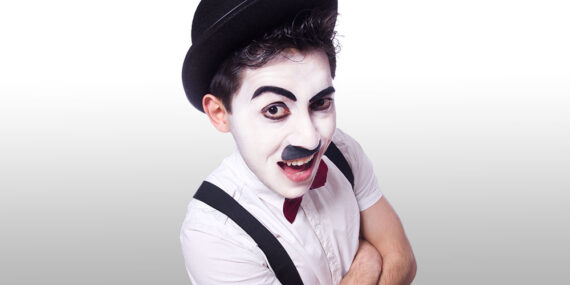The function of humor for the Trickster and the rest of your selves
By: Robert Stamboliev
A harmless joke from a client to ease the tension, the sarcastic joke from a client, in an attempt to feel superior, the cynical joke full of black humour that betrays someone’s hopeless perspective … Humour knows many faces in coaching and therapy.
Humour does much more than just causing laughter. Humour has various functions. In this article, I will address many of these different functions. Furthermore, I’ll connect a number of sub-personalities to these functions from the Voice Dialogue perspective. Half way through this article, I will zoom in on a special archetype: the Trickster. Finally, I’ll provide some tools for the coach/therapist on how to work with this archetype.
Functions of humour
Humour is serious business. Many faculties are studying humour: from brain to language researchers, from semantics to linguistics, from sociology to psycho(path)ology. Humour combines two or more inconsistent, inappropriate and incongruent parts or circumstances. This causes a shift in perspective, resulting in a new third position. This third position often has a function. It’s not without reason that we come across humour in coaching and therapy.
Morreall (1983) and Bergson (1993) distinguish between three important functions of humour in coaching and therapy:
- To cause incongruity in a playful, stimulating, creative and unexpected way;
- To influence the power relationship between the speaker and listener. This is often done in rather an aggressive and hostile manner so as to heighten superiority.
The release in laughter, to alleviate tension.
A healthy form of humour is free of pretence: this type of humour is light, creative, original, and it is and can be applied as a talent. But there is also humour with an after taste. We see this, for example, when the client tries to avoids any invitation to take a deep look at him or herself. Or if the coachee – often with the use of black humour or sharp digs– takes on a battle with the coach. Or – another such example – when someone does all they can to use humour so as not to disrupt the harmony.
Verbal humour and non-verbal humour
Nothing is more painful when your humour goes unnoticed, when nobody gets your joke. See Table 1 for a split between verbal and non-verbal humour, which may be helpful to the coach in identifying humour in the coach setting.
Table 1. Verbal and non-verbal humour
| Verbal humour | Non-verbal humour | Humour that occurs both as verbal and non-verbal |
| Figure of speech
Hyperbole or exaggerationNoëma Understatement Play on words Joke Sarcasm Funny accents or slips of the tongue
|
Facial expressions
Exaggerated and unexpected movements and gestures
Practical joke: deliberately setting someone up
Smiling/ twitching
|
Parody or imitation
Caricature Stereotyping Sketches Vulgar humour Self-deprecation Satire Black humour Feigned stupidity Absurdity Anti-humour: jokes with no point Unintentional humour |
Facial expressions warrant extra attention. This form of humour can be very subtle to the eye: a finger along the side of a nose predicts a joke, a pout betrays an inner dialogue or a naughty joke that no longer seems possible to tell. If the client laughs about something he said or thought, or about a comment the coach made, then the chances are that this laugh contains some valuable information. The coach can then directly ask: “What is your laugh?”
Humour and the various selves
In coaching it’s important that the coach can see from which part of the psyche the humour is coming. Both in himself and in the client. I look at humour through the lens of the Psychology of Selves. Better said: we look through this lens. That’s because the Psychology of Selves assumes that a person consists of parts, otherwise known as selves or sub-personalities. These sub-personalities are attached to their own ‘domain’ and are attached to certain outcomes. (Stamboliev, 1991; Stone & Stone, 2006). Humour can help here. As soon as humour shows up or serves some kind of purpose, then you can be sure that a sub-personality is directing this humour. All sub-personalities are on the one hand just who they are, and on the other hand – each in their own way –are either trying to avoid negative emotions (pain/sadness/fear/shame/guilt) or to achieve a certain goal. This is how the Trickster causes confusion, the Controller keeps control, the Pleaser wants to make everyone happy, and the Warrior is set on winning (table 2).
Table 2. The goal of humour for the Selves
| Function of humour | Sub-personality | Goal |
| To cause Incongruity | Trickster
|
To distract/confuse (‘How do I make sure that the other doesn’t get close to me?’) |
| To demonstrate Superiority | Controller
Warrior
Inner Critic/ Judge |
To maintain control and direction
(‘Can I keep control of this situation?’) To provoke a power struggle (‘who’s the boss here?’) To avoid making a mistake (‘Who or what can I criticise?’) |
| Release | Pleaser | To reduce the tension (‘How can I eliminate the tension I feel here as quickly as possible?’) |
Applying humour in order to allow for incongruity is the job of the Trickster. The Trickster – as an archetypes also known as the fool or the clown – uses humour to cause distraction or confusion. Take the client, who at the start of the session says: “I really don’t feel like this, do you?” The Trickster escapes as long as he can. We will shortly delve into this sub-personality in more detail.
If we take the theme superiority, then humour isn’t far away from the Controller, the Warrior and the Inner Critic. The Controller’s goal is to keep control. Always. In therapy or coaching he will avoid any form of fear and vulnerability. The Controller doesn’t want to reveal anything. The Controller uses humour to determine exactly what he wants to reveal to his environment. This is how we see him making jokes in order to divert any attention the coach might have on him. For example: “I’m good at reading other people’s thoughts. I always say: “Try me!”. He can also be very charming and ‘pretend’ that he will do better next time. You can really sense that he’s got his fingers crossed behind his back: no I won’t!
The Warrior is out to win. We see the Warrior attacking others. For example, by scornfully laughing at any suggestions the coach makes. In the Warrior’s eyes, his right to exist depends on winning. In both this and the next sub-personality, we come across mean and destructive humour and sarcasm.
The Inner Critic/Judge is the third sub-personality that has superiority as its main theme. They are the ‘criticasters’, the mean reviewers or critics who constantly judge the way we behave. The big difference between the Inner Critic and the Judge is that the Inner Critic is directed internally and he’s just waiting to beat you up when you make a mistake. The Judge is of the same calibre, only turned to the outside world. The Inner Critic/ Judge points to mistakes (often in a cynical or sarcastic way) in order to either make fun of himself or the other person. In rejecting oneself first, the Inner Critic avoids the pain of being rejected by others. The Judge judges the others. That can be both verbal and non-verbal (scornful laugh, raised eyebrow). The Judge is quick to blame others and finds fault in the outside world. The more the outside world is to blame, the more self-righteous the person feels. When this sub-personality is dominant, then we can talk about a form of dependent self-worth.
Using humour as a form of release is especially found in the Pleaser. The Pleaser uses light and funny humour to reduce all possible tension: “There’s no end to having a good time. But I do feel like a cup of tea!”. He uses humour to avoid confrontation. During a coaching session, for example, he can be the one using jokes to avoid silence. He hopes that his jokes will make him well liked and his intention is to be funny so that others have a good time.
Depending on the sub-personality, each form of humour has its own charge and meaning: that’s how black humour or so called Jewish humour can bring so much relief in suffering. It can ensure a healthy dose of self-mockery and the ability to put matters into perspective. Different stand-up comedians, such as Eddy Murphy, use this form of humour to cut through taboo subjects. In this way, energy is released that was otherwise blocked. From the Voice Dialogue perspective, we then talk about the release of energy from disowned sub-personalities. However, if this type of humour is channelled by a sub-personality like the Critic or the Judge, then this catharsis is avoided and the humour becomes distorted to a heavy cynical signal, not leading to any form of liberation.
The Trickster
Now that we have an overview of humour, its function and how we can connect humour to a number of sub-personalities, it is time to take a more closer look at one sub-personality in particular. The one that uses humour in the most subtle of ways: the Trickster. What characterises and motivates the Trickster and how do you deal with the Trickster in coaching, especially when it is this sub-personality that prevents the client from growing. In Voice Dialogue, we work towards helping clients to no longer stay imprisoned in one of the sub-personalities, but that we can freely choose the qualities, that all these selves house, from a new position. This new position we call the Aware Ego. The Aware Ego has a clear view of a much greater spectrum of sub-personalities and consciously chooses when it’s the turn of each part to show up.
The Trickster delights in all sorts of mischief, pranks and jokes. In Jungian psychology , the Trickster appears under the guise of the Idiot, the Harlequin, the Clown and the Fool . We come across the Trickster in mythological tales (such as the Nordic God Loki) and in fairy tales and stories, Reynard the Fox, Brother Rabbit and Coyote. Although he is not evil by nature, the results of the Trickster’s activities are sometimes very unpleasant; these activities centre around bringing attention to our own or other peoples often hidden stupidity or lies. The Trickster is also the unexpected ‘idiotic’ aspect of life which for no reason at all emerges into our carefully arranged life to upset it. The Trickster is a ‘shape shifter’, and so has the possibility of transformation: hereby demonstrating the elusive side of this archetype.
Useful questions and tips to get to know your Trickster better
*For whom am I a Trickster (or have been)?
* Who is (has been) a Trickster for me?
* Does the part of me that pokes at other people’s weaknesses or vulnerabilities does so caringly or hurtfully?
* What is my Trickster revealing to me about myself?
The Trickster may also be creative in a seemingly spontaneous sort of way. Because he doesn’t hold on seriously to a purpose or an idea, this inner aspect of our nature may lead us to something new, a change in direction. The Trickster has the ability to either laugh at the ridiculousness of life, or to cut through social norms and reveal our hypocrisy in an acceptable way. This archetype can make us laugh as often as it can make us cry and shows us the human feelings underlying the masks we might wear in daily life. Love, loss, success and failure: all have their deeply human side and the Trickster reveals such themes to us. Knowing all too well what drives people and where their vulnerabilities lie, the Trickster can also manipulate and reveal itself as a tormentor. (Jung, 1972).
The coach approach in working with a Trickster
What does the approach for coaching look like in practice. Below is a description of the different phases. These phases are not completely prescriptive, but based on a number of principles that appear in Voice Dialogue. I have interwoven these phases into the case of Victor.
Recognition
The first step is to recognise the Trickster and his accompanying humour as a client’s defence mechanism. If the therapist or coach doesn’t recognise and address this sub-personality, then there will be no point to the coaching or therapy. This statement of course applies to all sub-personalities, but it is especially the Trickster who is elusive and can disguise himself well. There can therefore appear to be nothing unusual, objectively speaking, about the client or his behaviour for quite some time. Furthermore, the Trickster – as his name suggests – is the expert by a long way when it comes to trickery (pretending, faking, blending in with the environment, the mask behind the mask). If the Trickster gets away with this, then it’s this sub-personality who’s determining the agenda!
Acknowledgment
In coaching, the coach respects that which is being avoided. The task is to honour the Trickster and the function he’s had in the past. As soon as you see that somebody is reacting via the Trickster, then the coach knows that he’s on important and sensitive ground. Which he meets and treats with care. Let’s take client Victor: he was raised by a dominant and narcissistic father. The Trickster helped to keep his vulnerability as far away as possible from his father’s influence. That’s how Victor learned to survive at home. Thanks to his Trickster, Victor became very successful in his working life.
Naming
As soon as the Trickster shows up in coaching, I confront the client with this sub-personality. In Victor’s case, when he makes a joke: ‘Every time that I touch on sensitive topics, you come up with a joke to escape. Whatever I try and do with you, it seems as if you want to keep control and play for time’.
Giving a voice
I suggest that Victor talks with the one who’s fooling around, the Trickster. I invite him to sit down in another chair. As soon as the coach has recognised the Trickster, then the Trickster feels that he’s been seen as it were. Provided that the Trickster has enough trust in you as a coach, then he actually finds the unmasking rather interesting. He can show – finally in front of a larger audience – all the things he’s achieved for the client. The Trickster is very proud of this. It is the conjurer who may finally reveal his tricks.
Extract from a typical Voice Dialogue interview between coach and Victor’s Trickster
Coach: ‘Welcome, how do you do that?’
Trickster (proud): ‘Yeah, I’m the one pulling all the strings. Whatever somebody from Victor’s environment tries to do, I’ve got my eye on the ball and I make sure that nobody gets near him.’
Coach: ‘Are you here now? ’
Trickster: ‘In every single exercise and technique that coaches try out with Victor, I am here. I always keep my eyes open. And I’m pretty quick to figure out what’s going on. Then I nicely bounce the game back.’
Coach: ‘Can you say something about how your week looks? What’s the first moment in the day when you’re on the lookout?’
Trickster: ‘The first thing I do when Victor wakes up is to see if his wife is already up. If she’s downstairs, then I’m preparing my first joke as I go down the stairs.’
Coach: ‘What help do you offer Victor then?’
Trickster: ‘I make sure it’s psychologically safe enough and I test the atmosphere.’
Coach: ‘Is this atmosphere between Victor and his wife often not so good then, at the beginning of the day?’
Trickster: ‘Actually, the atmosphere is always good. But you just never know.’
Interviewing
In the first stage of the interview, the coach asks concrete questions. He works phenomenological. His approach is descriptive by nature. In Victor’s case, the coach asks the Trickster more about what Victor does when he’s at home. He asks: ‘what do you do when Victor is at work?’ In the second phase of the interview process, the coach examines the actual experience of the Trickster. Whether he always carries out his task with full energy. If the Trickster ever gets tired. Once that picture becomes clearer, then the coach connects this with the past. The coach then asks Victor’s Trickster: ‘When did you come into Victor’s life?’ In so doing, the Trickster comes into contact with his vulnerability. At this point, Tricksters can often be moved. Victor’s Trickster: ‘Victor was often bullied by his father at home. So many fits, you never knew what could happen next. Victor never knew what to expect. That’s when I showed up. I became increasingly better at warding off these fits. I also started taking on this role for Victor’s younger sister and even for his mother’. At the end of this discussion, I asked the Trickster what he has done for Victor: ‘I protected Victor and the rest of his family against Victor’s father.’
Negotiating
If a client has developed a so-called ‘primary self’, a part that is so strongly developed that it suppresses the other parts, then we explore who else is living in Victor’s inside world and whose voice has hardly been heard yet. Because the Trickster has been valued, invited and interviewed, Victor has his first conscious experiences of this energy. There has been a negotiation with the Trickster and he has, after some time, agreed to let other parts of Victor speak, provided that the Trickster may intervene between them if he wants to. This is the start of separation from this role. We can now talk about a working partnership between the coach and the Trickster.
Other selves
As soon as we now invite the other sub-personalities to show themselves, even more energy starts to flow. Other selves will come to speak of their own free will and with more energy. Firstly, the Vulnerable self that was suppressed. Let the client then welcome and feel the Sadness that starts to surface. It is already incredibly healing experience the energy of vulnerability. Then many other selves appear, who have been suppressed up until now, such as Trust or the Egotistical self…
The Middle Position
Vulnerability gets a new position within Victor. In this phase, the coach works with Victor in dealing with this vulnerability in a new way. The principles of non-violent communication can be very supportive here. The one client will need to learn to shut himself off from external stimuli, so that he is less affected by the outside world. Other clients must learn to be more open. In Victor’s case, he learned to address matters sooner if he didn’t like something (setting boundaries) and to express what he did want (‘this is what I need’).
Coaching in this way requires a number of special skills from the coach. First of all, there’s a thin or even non-existent line when it comes to therapeutic interventions. We talk about coaching with a therapeutic touch. Supervision and intervision is therefore compulsory. Otherwise, there’s a big chance that you’ll cause more damage to the client than the coach is able to repair. Inviting the client to work comes from a place of acceptance and not from a place of fighting or struggle. The coach applies his own sense of humour and amazement to the situation (‘Wow, that’s really professional of you’, ‘you almost had me fooled there, but luckily I’ve also got a Trickster on standby!’). The coach can in fact only have a dialogue with the Trickster, if the coach knows his own Trickster well. During the coaching, the coach often seeks advice from his own sub-personalities and taps into these in order to feel what is happening in the moment and what is now needed. This means that the coach has worked on himself and his own selves: these selves have, under professional guidance, all had sufficient chance to have spoken out, to have become deeply acquainted with all their many layers and manifestations.
The Aware Ego
The last phase of the coaching approach when working with the Trickster is to expand on the middle position. This is also the objective if the client has various sub-personalities standing before him: from the coaching perspective, the point of departure now is allowing the so-called Aware Ego to emerge, a ‘free middle position’, from which contact is made with all the different sub-personalities. From this free position, Victor consciously chooses which sub-personality needs more attention in each passing moment.
Humour employed by an Aware Ego
In unraveling the various selves, humour can be used as a diagnostic instrument. In order to arrive at the Aware Ego, humour can also actively be used as an intervention. After all, humour has a spiritual and healing power, plus the power to put matters into perspective. When we are able to laugh about our barriers and pain, we surpass our feeling of being broken, through which bruised relationships and crumbled connections can also be repaired (De Blot, 2013). In developing the Aware Ego, the coach gives special attention to the client’s contact with his own strength and vulnerability. Behind the humour of a sub-personality, vulnerability is always hiding in the shadows. The client can learn to attend to this vulnerability by developing an Aware Ego and then to operate from this Aware Ego. In this way, humour can be used positively and freely. (Table 3).
Table 3. Humour through an Aware Ego
| Function of humour | Sub-personality | Through the Aware Ego |
| Causing Incongruity | Trickster
|
This is very funny humour, with no loss of depth in the contact. Essence remains intact in the contact. |
| Showing Superiority | Controller, Warrior or Inner Critic/ Judge | The sarcastic edge disappears from this humour or becomes multi-layered: not just mockery but also self-mockery. Less fixation. |
| Release | Pleaser | Humour we see in the gentle smile of Buddha. Recognition (‘I’ve been there’). |
When humour comes from the Aware Ego, it is light. This is because jokes are no longer being made to protect somebody or to defend something. Humour coming from the Aware Ego may simply be humour and can bring joy and pleasure via unexpected and witty jokes. This type of humour is purely intended for enjoyment: humour just as humour is meant to be.
About the author
Robert Stamboliev studied psychology in California, where he achieved his Masters degree in 1988. He has been trained in Voice Dialogue and the Psychology of Selves since 1982 by Dr. Hal and Dr. Sidra Stone and was the first to develop Voice Dialogue training programs in the Netherlands and other European countries, including Russia and Turkey. Robert is the founder and director of the Institute for Transformational Psychology (ITP) in Bergen, Netherlands. The institute offers (educational) courses and individual-, relationship- and organizational coaching. Robert wrote the book The Energetics of Voice Dialogue in 1988. See www.voicedialogueworld.com .
References
Bergson, H. (1900). Le Rire. Essai sur la signification du comique. Paris : Editions Alcan
Blot SJ, P. de Chauvigny de (2013). Reflection of Paul de Blot SJ in ‘nieuwsbrief rondom werkcolleges 2012-2013’, Breukelen: Nyenrode Business University.
Halbertsma, E.H. & R. Stamboliev (2002). Polarities in personal coaching, Opleiding & Ontwikkeling, nr. 10, pp. 24-27.
Jung, C. G. (1972). Four archetypes. Mother, Rebirth, Spirit, Trickster. Vert. R.F.C. Hull. London: Routledge & Kegan Paul.
Morreall, J. (1983). Taking Laughter Seriously, New York: SUNY Press.
Stone, H. & Stone, S. (1985). Embracing Our Selves. Novato (CA): New World Library.
Stamboliev, R. (1988).The Energetics of Voice Dialogue. California: LifeRhythm.















